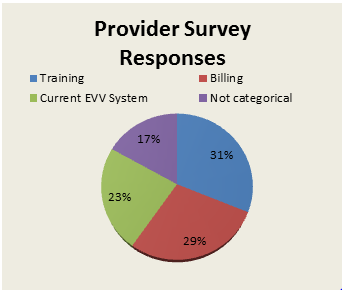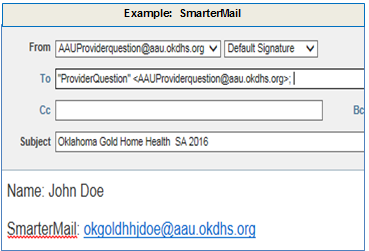Provider Update: April 20, 2016
Electronic Visit Verification (EVV) Transition Preparedness
On March 25, 2016, MSU posted the first of what will be a series of EVV transition notices, announcing the successful bidder receiving the EVV contract award, First Data Government Solutions, (FD). The topics that will be addressed in this update include:
- The results of the recent EVV survey
- Critical steps toward transition
- Identification of EVV systems administrators at the provider level
| Providers were asked to complete an online survey to specify needs/concerns in transitioning to new EVV software. The survey was initiated onMarch 30, 2016, and it ended on April 10, 2016. There were 77 responses that fell within four specific categories, which included training (24/31%), billing (22/29%), current EVV systems functionality (18/23%), and an array of issues that were 'not categorical' (13/17%). |  |
Training:All responses related to training issues had to do with the adequacy and availability of training. Additionally, the survey was a question as to the number of attendees providers expected to be trained.
When providing training of this magnitude is necessary to employ the "train the trainer model", which means fewer will be trained to train the many. It is expected that Providers will designate a maximum of 3 individuals to participate and serve as trainer for staff within the agency. Representation for each agency (or branch office as appropriate) should minimally include:
- The proposed administrator for the FD system at the provider level (this will be the person who sets up users and user roles in the system)
- Billing staff
- Provider agency staff trainers.
Ultimately, staff fulfilling any role may attend, but the limit will be 3, however this does not preclude providers having multiple locations from sending representatives from each region of the state. This is not a training intended for all agency staff.
MSU is in the process of finalizing a training plan with FD. While we cannot offer specific dates at this time, these dates will be provided within the first week in May. We anticipate making training available at least 30 days prior to the "Go live" date and multiple opportunities for training will be made available. Provider expense and convenience was considered in developing the training plan and we will attempt to offer both in-person and remote access training, which will afford providers to access training from any desired location.
Billing:Overall concerns expressed in responses related billing communicated providers' need for continuity for claims processing through the EVV software transition. MSU is working closely with FD to prevent billing delays and complications. Included in this bulletin are steps providers should take to ensure smooth transitioning for billing (see PART B of this bulletin). These steps will address claims pending in Sandata's EVV system as well as preparation for processing claims in the FD EVV system. Please follow these steps as outlined, in order to avoid potential delays and billing related issues.
Current EVV System: Respondents submitted some concerns that are related to the functionality of the Sandata System. In making this transition the First Data software solution will be installed, and processing of claims and billing will be handled differently. We do not anticipate that providers will experience the same issues. Immediately following the "Go live" date, weekly provider calls will ensue with First Data, and if there are issues they will be addressed in this open format.
Non Categorical:There were some responses that did not fit within a specific category and therefore a one-to-one response is presented below
| Additional Questions and Answers | |
| Provider comments/questions/concerns | Generalized responses |
| 1. Ensuring our HR/Payroll system works with the new vendor | The First Data EVV system will have downloadable reporting available generating suitable data for assisting with processing payroll |
| 2. Smooth transition with efficient technical support | Vigorous communication will ensue throughout the course of the implementation and we will address any potential issues we find and communicate the results as soon as possible |
| 3. How to deal with the multiple failures of the EVV system, how to fix these errors, etc. | We will now have a new software vendor and do not anticipate the same issues that occurred with the current software in use. |
| 4. Availability of claim data in a dynamic (highly scalable, highly flexible, easily modified) format, availability of payment data linked to original claim, ease of use for field staff, dynamic scheduling | MSU will be announcing process changes that will result in creating a better link between payment data to the original claim. |
| 5. We do not know what is expected of us to make the transition, so we do not know what our most pressing issue will be at this time besides lack of information. | MSU will be issuing a series of preparatory bulletins to better ensure a smooth transition |
| 6. Authorizations, Staffing, Scheduling and Billing | MSU will be issuing a series of preparatory bulletins to better ensure a smooth transition |
| 7. Getting a correct aging report and correct authorizations, will there be aging report. Will it move the units that got denied over? Will remits be uploaded to new system? | The First Data EVV system has functionality that will reconcile units used. |
| 8. Accuracy of all our information being transferred correctly with little effort | This is an issue MSU is currently discussing with First Data and we will be providing additional information in future bulletin topics. |
| 9. We need the ability to download a comma delimited file (CSV) containing (at minimum) the member's name and Medicaid number, the employee's name and social security number, the date of service, the service code (with modifiers if they exist), the units, the dollar amount and (if applicable) the date billed. | The First Data EVV system will have downloadable reporting available generating suitable data for assisting with processing payroll. All AuthentiCare reports are available in PDF, Excel, CSV, and XML. |
| 10. That the reports work like they are supposed, IE the time and attendance rolling over all the billing and being able write notes in the notes section and exporting them into a file/format that can be printed. | We do not anticipate issues with reporting; however there will be opportunities for providers to ask questions about reports during training. Some reporting may be available for testing during this period. |
| 11. All employees need updated EVV sign in/code numbers. | This is an issue MSU is currently discussing with First Data and we will discuss this in future bulletin topics. |
- Current billing: It is essential that providers billing be current in lieu of the pending EVV transition. Providers should immediately begin to purge the Sandata system of all pending claims to the greatest extent possible. At the point at which a transition from the Sandata system to First Data's AuthentiCare system occurs, all claims that are pending in the system must be in a CONFIRMED STATUS, or billing that is ready to be exported for payment. This billing will be exported from the Sandata system and transmitted to First Data to serve as 'Submitter', to OHCA. The Sandata and AuthentiCare systems do not process claims in the same manner so it is not possible to export claims data from Sandata to be imported into AuthentiCare (FD) that has not been fully processed and ready to export for payment. We are alerting providers now, as we understand that in some cases providers are waiting for service plan authorizations so that billing can be completed, such as a case where there were insufficient units to bill. Regardless of the status of the claim that is resident in the Sandata system, MSU will obtain files that include all pending data, although it may not be readily available, as we will have to receive the delivery of the data and process it for distribution and subsequent billing.
- Validate billing profile: First Data (FD) would like to begin the work of setting up provider billing profiles. MSU will ensure that the data transmitted to FD will be accurate and to lessen the risk of billing being denied. A survey has been posted at https://surveys.okdhs.org/TakeSurvey.aspx?SurveyID=l41Mnl9 and providers are asked to follow the link and complete the survey. It is critical that the validation of billing profiles occurs no later than April 27, 2016.
PART C System Administrators:
| Systems Administrators (SA): MSU willsend a request to all providers, via SmarterMail on April 21, 2016, requesting providers submit the name, SmarterMail address, address, and contact phone number of the individual that will be designated as the SA for the AuthentiCare EVV implementation. If a provider does not have an EVV SmarterMail address please submit a request and we will assist you in processing a request to obtain one. The assigned individual will designate user role assignments within the EVV system. Please respond no later than April 27, 2016. |  |
The MSU along with First Data are working to ensure successful transition. Please respond to any item included in this communication that requires action as soon as possible, which will better ensure a successful transition.
Contact evvok@aau.okdhs.orgfor all questions or concerns regarding this bulletin.


